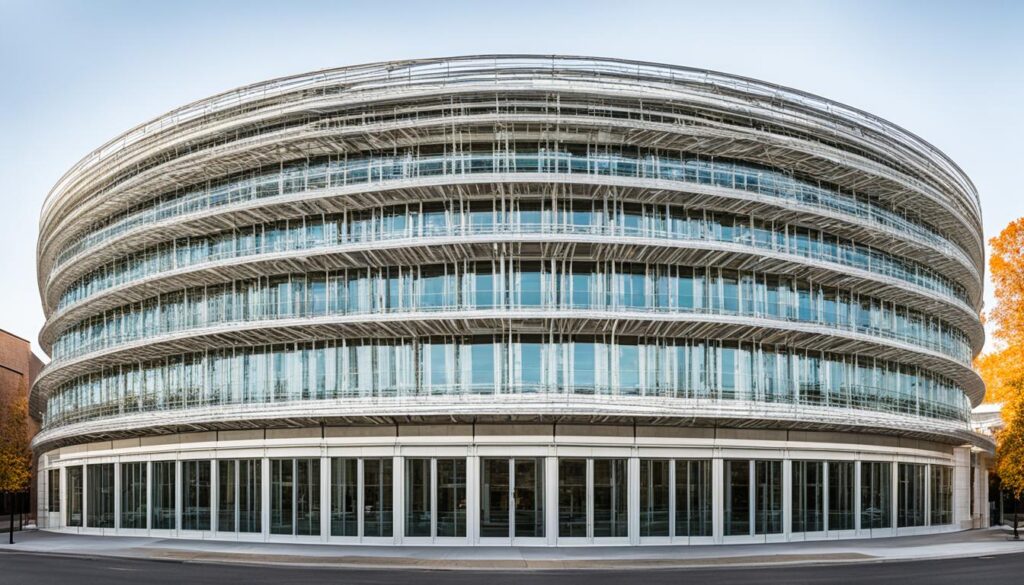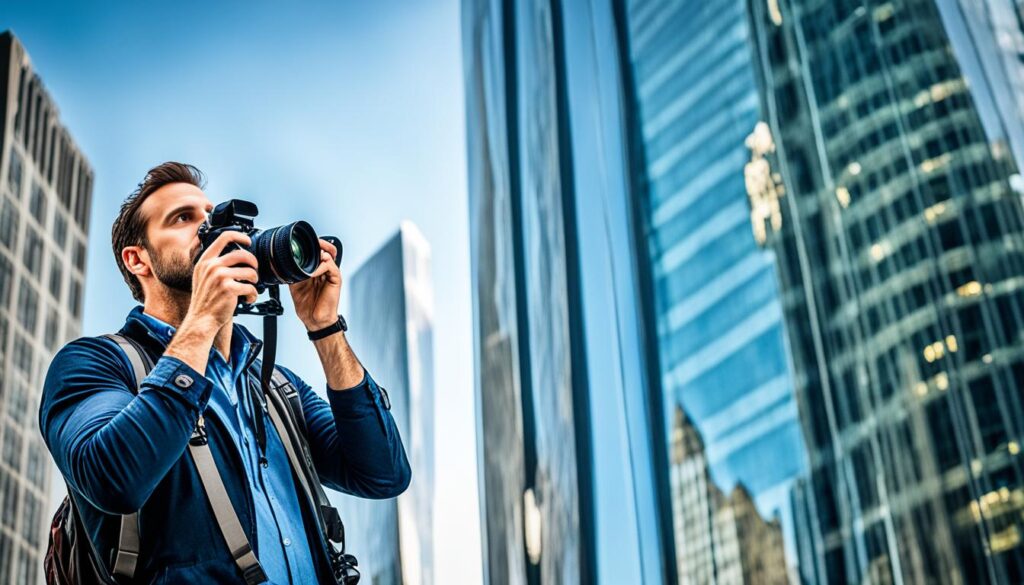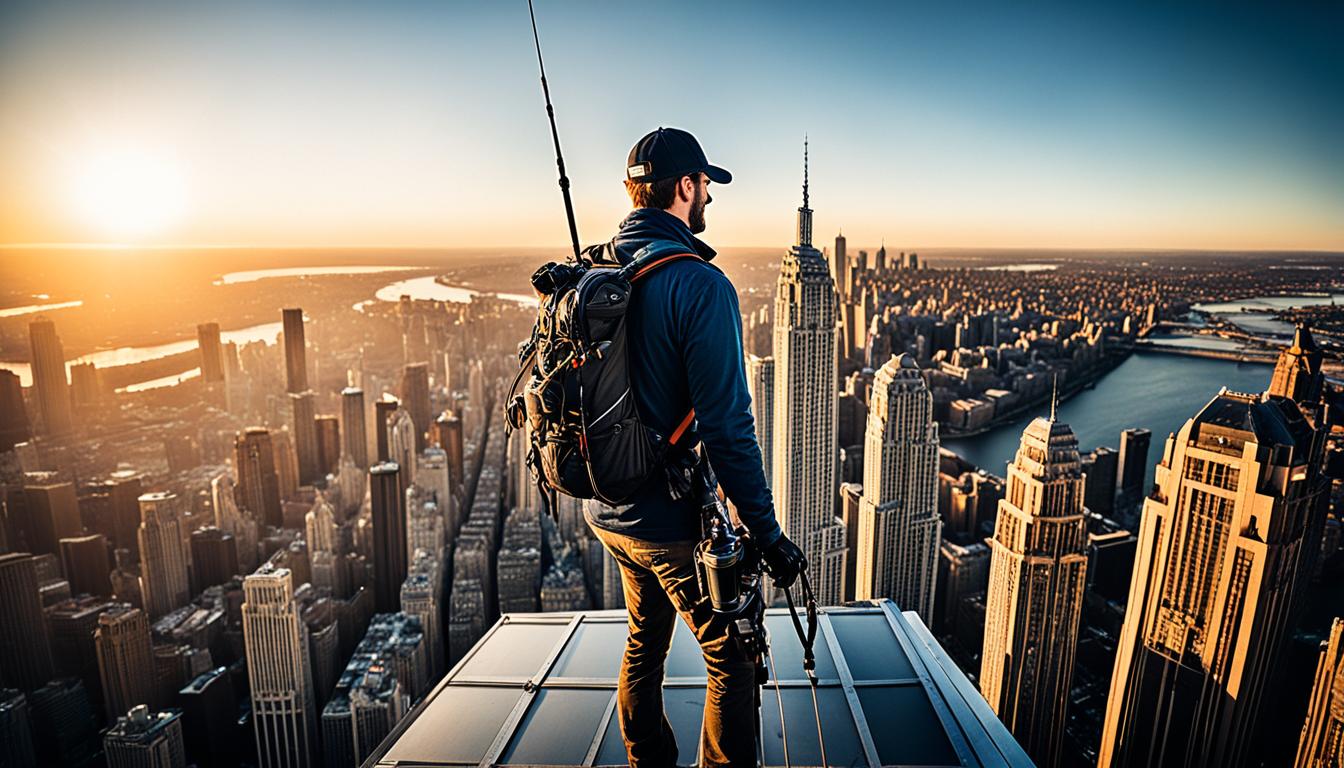How to Become an Architectural Photographer
Have you ever found yourself captivated by the intricate details of architecture, marvelling at how a building can tell a story through its design? That’s the power of architectural photography. As a passionate photographer with a keen eye for the artistry of buildings, I embarked on a journey to become an architectural photographer, blending my love for photography and architecture into a fulfilling career. Let me guide you through becoming an architectural photographer, from mastering the fundamentals to building a stunning portfolio showcasing your unique style and vision.
Key Takeaways:
- Develop a deep understanding of photography fundamentals, including composition, exposure, lighting, and camera settings.
- Invest in high-quality photography equipment, such as a full-frame camera, perspective control lens (PC), and a sturdy tripod.
- Build a strong portfolio by capturing captivating architectural images and showcasing your work on platforms like Instagram and your website.
- Seek guidance from a mentor in architectural photography to enhance your skills and gain valuable insights.
- Gain real-world experience by assisting established professionals and continuously practising different techniques.
Understanding the Basics of Architectural Photography
To become a skilled architectural photographer, it is essential to have a deep understanding of the fundamentals of photography. Mastery of these basics will enable you to capture stunning images showcasing architectural structures’ beauty and intricacies.
Why Mastery of Photography Fundamentals is Crucial
When it comes to architectural photography, composition, exposure, and lighting play crucial roles in capturing the essence of a building. By mastering these fundamental concepts, you can create images that effectively convey the architectural details and highlight the unique design elements.
Composition involves arranging the various elements within the frame to create a visually appealing and balanced image. This includes considering the placement of architectural elements, lines, shapes, and patterns. By understanding composition techniques, such as the rule of thirds or leading lines, you can bring depth and visual interest to your photographs.
Exposure refers to achieving the right balance of light and dark in an image. Proper exposure ensures that the architectural details are well-defined and properly exposed. Understanding exposure settings, such as aperture, shutter speed, and ISO, will allow you to control the amount of light entering the camera and capture the desired level of detail.
Lighting plays a crucial role in architectural photography. It can dramatically affect an image’s mood, texture, and overall aesthetic. Natural light, such as the golden hour or diffused sunlight, can create a warm and inviting ambience. Similarly, artificial light, such as interior or exterior lighting, can be used strategically to highlight specific architectural features and add depth and drama to your photographs.

By mastering the fundamentals of photography, including composition, exposure, and lighting, you will be well-equipped to capture the beauty and intricacies of architecture. These essential skills will serve as the foundation for your journey as an architectural photographer, allowing you to create captivating images that showcase the unique qualities of buildings and structures.
Developing Your Photographer’s Eye
Developing your photographer’s eye is essential for capturing unique and captivating architectural photographs. It requires a keen sense of observation and an understanding of composition, framing, and visual storytelling. By paying attention to these elements, you can create impactful images that engage viewers and convey the essence of the architecture.
To develop your photographer’s eye, train yourself to notice and capture details and unique angles that tell a story about the architecture. Take the time to explore different perspectives and viewpoints, experiment with angles and heights, and look for opportunities to showcase the architecture in a way that adds visual interest.
Composition plays a vital role in architectural photography. You can create a sense of balance, harmony, and visual flow by carefully arranging the elements within the frame. Consider the rule of thirds, leading lines, and the use of negative space to create visually appealing compositions.
Framing is another critical aspect of architectural photography. Pay attention to how you frame the architecture within the frame. Look for natural frames, such as doorways or windows, to add depth and create a sense of place. Experiment with different framing techniques to create unique and visually captivating images.
Visual storytelling is the art of using images to convey a narrative or evoke emotions. Consider the story you want to tell with your photographs and how to use composition, lighting, and perspective to enhance the narrative. Consider the architectural details that can add depth and character to your images.
Lastly, cultivate your artistic vision and develop a personal style that distinguishes your work. Embrace your unique perspective and use it to capture architectural photographs that showcase your creative vision and individuality.
By developing your photographer’s eye, you can elevate your architectural photography and create images that engage viewers and evoke a sense of wonder in the built environment.

Investing in the Right Gear for Architectural Photography
When it comes to architectural photography, investing in the right gear is crucial for achieving high-quality photographs that capture the beauty and details of buildings. The right camera equipment, tripod, lenses, filters, and accessories can significantly affect the outcome of your architectural images.
Camera Body: Select a camera body that meets your specific needs. Look for a full-frame camera that offers excellent image quality and low-light performance.
Lenses: Invest in various lenses to enhance your versatility as an architectural photographer. Wide-angle lenses, such as a 16-35mm or a tilt-shift lens, are ideal for capturing expansive interiors and architectural details.
Tripod: A sturdy tripod is a must-have tool for achieving sharp images, especially in low-light situations. Look for a tripod that provides stability and ease of use.
Filters: Filters can control light and enhance specific aspects of architectural photography. Consider using neutral density filters for long-exposure shots, polarizing filters for reducing reflections, and graduated neutral density filters for balancing exposure in landscape photography.
Accessories: Don’t overlook the importance of accessories such as lens hoods, lens cleaning kits, memory cards, and extra batteries. These small accessories can greatly contribute to your overall shooting experience.
Gear Maintenance: Proper maintenance and care of your gear are essential for ensuring longevity and optimal performance. Regularly clean your lenses, check for any signs of wear and tear, and store your equipment in a safe and dry environment.
Gear Selection: With the plethora of options available in the market, choosing the right gear for your architectural photography needs can be overwhelming. Take the time to research and seek recommendations from experienced architectural photographers who can provide valuable insights and advice based on their experiences.

Investing in the right gear is important for capturing stunning architectural photographs. With the right equipment and proper maintenance, you can elevate your photography and create images that showcase the beauty and intricacies of architecture.
Crafting a Compelling Architectural Portfolio
A well-crafted portfolio is essential when presenting your skills and expertise as an architectural photographer. It serves as a visual representation of your work and showcases your ability to capture the beauty and intricacies of architecture. Here, I will guide you through creating a compelling architectural portfolio that will impress potential clients and leave a lasting impression.
Choosing the Right Projects to Showcase Your Skills
Curating an impactful architectural portfolio starts with carefully selecting the projects that best highlight your skills and style. Choosing a diverse range of projects showcasing your versatility and expertise in capturing different architectural styles, unique features, and interesting compositions is important.
Include a variety of architectural spaces in your portfolio, such as interiors, exteriors, and detailed shots. This demonstrates your ability to capture the essence of different environments and showcase the finer details of the architecture.
Remember, quality is more important than quantity. Select a smaller number of projects that truly reflect your best work and align with the type of clients you want to attract. Each project should tell a compelling story and highlight your technical abilities, creative vision, and attention to detail.
When choosing projects, consider the following:
- Architectural styles that you excel in capturing
- Projects that emphasize your unique style and creative approach
- Buildings with interesting and eye-catching features
- Projects that challenge you to push boundaries and experiment with different techniques
Taking the time to curate a portfolio that accurately represents your skills and showcases your best work will significantly impact potential clients and set you apart from your competitors.
Utilising Social Media and Your Website for Maximum Exposure
In today’s digital age, social media and websites play a crucial role in promoting your architectural photography. They offer a platform for you to showcase your portfolio, connect with potential clients, and cultivate an online presence.
Start by creating a professional website that serves as a central hub for your portfolio. This will allow potential clients to easily view your work and learn more about your services. Ensure that your website is visually appealing, easy to navigate, and showcases your projects in an organized and engaging manner.
Additionally, leverage the power of social media to extend your reach and connect with a wider audience. Platforms like Instagram, Facebook, and Pinterest allow you to share your work, engage with followers, and connect with potential clients. Regularly update your social media profiles with captivating images from your portfolio, behind-the-scenes content, and insights into your creative process. Engage in meaningful interactions and build relationships with your audience and fellow professionals in the industry.
Remember to include links to your social media profiles and website within your portfolio and on your business cards, ensuring that potential clients can easily access more of your work and contact you.
Navigating Feedback and Using It to Your Advantage
Feedback is an invaluable tool for growth and improvement as an architectural photographer. Constructive criticism can help you identify areas to refine and develop, ultimately enhancing the quality of your portfolio and your skills as a photographer.
When seeking feedback, contact professionals in the industry, fellow photographers, and mentors who can provide honest and insightful critiques. Consider joining photography communities or forums where you can share your work and receive feedback from a supportive community.
Take feedback with an open mind and use it to your advantage. Analyze the comments objectively and look for patterns or specific areas of improvement that can be applied to your future projects. Embrace feedback as an opportunity for growth and refinement, and continuously strive to elevate the quality of your work.
Remember, a compelling architectural portfolio is an evolving body of work that reflects your growth and improvement as a photographer. Regularly update and refine your portfolio as you develop new skills and undertake exciting projects.

| Benefits of a Compelling Architectural Portfolio | Tips for Effective Portfolio Presentation |
|---|---|
| 1. Attracts potential clients and showcases your skills | 1. Organize your portfolio in a logical and visually appealing manner |
| 2. Leaves a lasting impression and differentiates you from competitors | 2. Include a concise yet compelling introduction or artist statement |
| 3. Demonstrates your ability to capture diverse architectural styles | 3. Use high-quality images and avoid clutter or excessive effects |
| 4. Allows potential clients to visualize their projects through your lens | 4. Include a variety of project types, such as interiors, exteriors, and details |
| 5. Showcases your creativity, technical abilities, and attention to detail | 5. Regularly update and refine your portfolio to reflect your growth as a photographer |
A compelling architectural portfolio is a powerful tool that can significantly impact potential clients and open doors to exciting opportunities. By carefully curating your projects, leveraging social media and your website, and embracing feedback, you can craft a portfolio that effectively showcases your skills, attracts clients, and elevates your career as an architectural photographer.
Studying the Works of Renowned Architectural Photographers
Studying the works of renowned architectural photographers is a valuable source of inspiration and learning. By analyzing their techniques, styles, and portfolios, you can gain valuable insights into the art of architectural photography and apply these lessons to enhance your work.
Renowned photographers have honed their skills through years of experience and have established themselves as experts in the field. Their portfolios showcase various compositions, lighting techniques, and approaches to capturing architectural elements.
Studying these portfolios allows you to understand the photographer’s creative vision and thought process. You can observe their use of light, composition, and perspective, and incorporate these techniques into your photography.
While studying, make note of the variety of architectural styles, structures, and details that the photographers have captured. This will broaden your understanding of the field and help you develop your artistic style.
By learning from the experts and analyzing their work, you can gain a deeper appreciation for the nuances of architectural photography. This exploration will inspire you, push your creativity’s boundaries, and elevate your skills and portfolio to new heights.
Finding a Mentor in the World of Architectural Photography
Finding a mentor in architectural photography can be invaluable for guidance and support as you develop your skills and navigate the industry. With a wealth of experience, a mentor can offer insights, feedback, and career advice to help you grow and succeed in your architectural photography career.
One way to find a mentor is by seeking opportunities to connect with experienced photographers at networking events, workshops, and online platforms. Engaging with photographers who have established themselves in the field can provide you with industry connections and open doors to new learning experiences. Attend events where you can meet professionals, exchange ideas, and gain valuable insights from their expertise.

How to Become an Architectural Photographer Through Real-world Experience
When pursuing a career in architectural photography, gaining real-world experience is invaluable for honing your skills and progressing. By assisting established professionals and practising various techniques, you can develop your expertise and enhance your chances of success.
The Value of Assisting Established Professionals
Assisting experienced architectural photographers offers a unique opportunity to learn directly from industry experts. By shadowing professionals on real-world shoots, you can observe their techniques, gain practical knowledge, and witness effective problem-solving. This hands-on experience allows you to learn the technical aspects of architectural photography and understand the nuances of client interactions, workflow management, and logistical considerations.
Assisting established professionals also provides a chance to network and build meaningful relationships within the industry. These connections can open doors for future collaborations, referrals, and mentorship opportunities. Learning from those who have already established themselves in the field can be invaluable in propelling your career forward.
Practice Techniques: From Trial and Error to Proficiency
Practising different techniques is crucial for enhancing your skills as an architectural photographer. While knowledge gained from books and online resources is valuable, applying that knowledge in real-world scenarios is where true growth occurs. You can refine your craft and develop your unique style by practising different techniques, experimenting with equipment, and exploring creative approaches.
Don’t be discouraged by failures or mistakes. Trial and error are an integral part of the learning process. Embrace these challenges as opportunities to improve and push your boundaries. With persistence and a growth mindset, you can transform setbacks into valuable lessons that propel your career progression.
Persistence and the Road to Architectural Photography Success
Embarking on a career in architectural photography requires persistence and dedication. Success does not happen overnight but through consistent effort and continuous improvement. The journey may be filled with obstacles and self-doubt, but staying committed to your passion and vision will ultimately lead to breakthroughs and achievements.
Understand that setbacks are a natural part of the process. Embrace persistence as a driving force behind your growth. Commit to ongoing learning, staying up-to-date with industry trends, and constantly pushing the boundaries of your creativity. With persistence, you can navigate the challenges and carve a successful path in the competitive world of architectural photography.

Marketing Your Architectural Photography Services
Developing effective marketing strategies is crucial for promoting and growing architectural photography services. To reach a wider audience, it is important to establish a strong online presence through your website, social media platforms, and online directories. This will enable potential clients to easily find and contact you.
One of the key elements of marketing your architectural photography services is to create a strong brand identity that resonates with your target audience. This involves defining your unique value proposition and showcasing your expertise and style. You can attract clients seeking your specific skills and aesthetics by highlighting what differentiates you from your competitors.
Creating promotional materials, such as brochures and business cards, is another effective way to showcase your work and services. These materials should be professionally designed and visually appealing, reflecting the quality and attention to detail you bring to your photography. You can make a lasting impression on potential clients by including examples of your best work and communicating the benefits of working with you.
Collecting and displaying testimonials from satisfied clients is also a powerful marketing tool. Positive testimonials build credibility and trust and provide social proof of your expertise and the value you bring to your clients. Consider contacting past clients and kindly asking them for feedback and testimonials that you can feature on your website and promotional materials.
“Working with [Your Name] was an absolute pleasure. Their architectural photography skills are truly exceptional, and they captured the essence and beauty of our building perfectly.” – Client Name
Remember, marketing is an ongoing effort that requires consistency and adaptability. Continuously monitor and evaluate the effectiveness of your marketing strategies, making adjustments as necessary to ensure that you are reaching and engaging your target audience. Stay current with the latest marketing trends and techniques, and be open to exploring new avenues for promoting your architectural photography services.
By implementing these marketing strategies effectively, you can increase your visibility, attract new clients, and ultimately grow your architectural photography business.

Networking and Building Industry Relationships
Networking and building industry relationships are vital for expanding your client base and gaining new opportunities in the architectural photography industry. By connecting with architects, interior designers, builders, and other professionals, you can establish valuable connections that can lead to collaborations and new projects.
To start networking, consider attending architectural events, conferences, and workshops. These gatherings provide excellent opportunities to meet industry experts and professionals more casually. Engage in conversations, exchange contact information, and follow up with potential contacts to nurture these relationships.
Online networking platforms like LinkedIn offer convenient ways to connect with potential clients and collaborators. Create a professional profile that highlights your skills, experience, and portfolio. Join relevant groups and participate in discussions to showcase your expertise and expand your network.
Collaborations with other professionals in the industry can greatly enhance your portfolio and reach. Consider reaching out to architects, interior designers, and builders to discuss potential projects where you can collaborate and complement each other’s work. Building these collaborative relationships can lead to new opportunities and exposure.
Networking and building industry relationships are ongoing processes. Stay active and engaged in the industry by attending events, participating in online discussions, and nurturing the connections you have made. By establishing a strong network of industry professionals, you can open doors to new projects, clients, and opportunities in the architectural photography field.
Becoming a Specialist: Finding Your Niche in Architectural Photography
Why Specialization Can Be More Lucrative
Becoming a specialist in a specific niche of architectural photography can lead to more lucrative opportunities. Clients often seek photographers with expertise and a deep understanding of specific architectural styles or types.
Understanding Industry Trends and Client Preferences
Understanding industry trends and client preferences is crucial in architectural photography. By staying informed and up-to-date on the latest trends, you can position yourself as an expert in your niche. This will attract more clients and allow you to tailor your work to meet their specific preferences and needs.
The Benefits of Niche Marketing in The Architectural Photographer’s Career
Niche marketing can bring numerous benefits to the career of an architectural photographer. By focusing your marketing efforts on a specific niche, you can stand out from the competition and establish yourself as a go-to expert. This targeted approach allows you to attract clients specifically interested in your niche, leading to more meaningful and profitable projects.
Conclusion
Becoming an architectural photographer is a challenging yet rewarding career choice for those passionate about photography and architecture. It requires a combination of technical skills, creativity, and a deep appreciation for the intricate details of buildings. You can showcase your expertise and attract potential clients by developing your photography skills and building a strong portfolio.
Effective marketing and networking are crucial in establishing yourself in the industry. You can create a strong online presence and reach a wider audience through social media platforms and your website. Networking with architects, interior designers, and other professionals in the industry can help expand your client base and open doors to new opportunities.
Continued learning and seeking mentorship are essential for growth as an architectural photographer. By studying the works of renowned photographers and connecting with experienced professionals, you can gain valuable insights and further refine your craft. Additionally, staying updated with industry trends and specializing in a niche can set you apart from the competition and lead to more lucrative projects.
Embrace the journey and persevere in the face of challenges. Architectural photography requires patience, dedication, and a keen eye for detail. With passion and perseverance, you can carve out a successful career in this exciting field and capture the beauty of architecture for years to come.
FAQ’S
Q: How do I start as an architectural photographer?
A: To start out as an architectural photographer, it is important to first develop your photography skills and learn about architectural photography. You can also consider reading photography books that focus on architecture to enhance your knowledge in this niche.
Q: What kind of lens do I need for architectural photography?
A: When it comes to architectural photography, a wide-angle lens is typically recommended as it helps capture the entire building or structure in the frame. This type of lens allows you to showcase the architecture in its entirety.
Q: Are there any tips for aspiring architectural photographers?
A: Aspiring architectural photographers should focus on mastering the basics of photography, understanding architectural composition, and continuously practicing to improve their skills. It is also beneficial to study the work of top architectural photographers to gain inspiration.
Q: How important is post-processing in architectural photography?
A: Post-processing, particularly using software like Photoshop, plays a significant role in enhancing architectural photos. It allows photographers to adjust lighting, colors, and composition to achieve the desired final result.
Q: What are some key factors to consider when pursuing a career in architectural photography?
A: When pursuing a career in architectural photography, it is crucial to have a keen eye for detail, a good understanding of architectural elements, and the ability to capture the essence of a building through your photographs. Networking with professionals in the industry can also help you get started as a photographer.
Q: How can I establish myself as a professional architectural photographer?
A: To establish yourself as a professional architectural photographer, you’ll need to build a strong portfolio showcasing your best architectural photos. Don’t forget to market your services and network with architects and real estate professionals to attract potential clients.
Q: What is the business side of architectural photography like?
A: The business of architectural photography involves marketing your services, pricing your work appropriately, managing client relationships, and understanding licensing and copyright laws. It’s important to run your photography business professionally to succeed in this competitive field.








